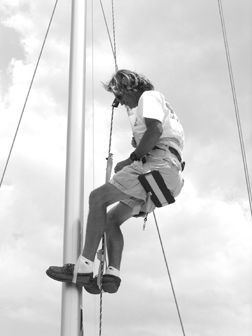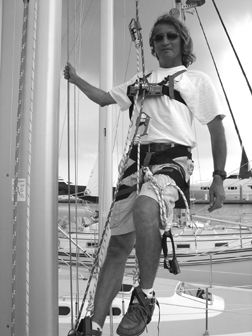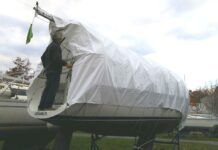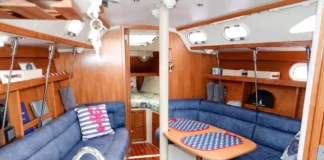
Earlier this year, celebrated singlehanded sailor Ellen MacArthur was feted at the dock in Falmouth, UK, upon returning from a record-setting, 71-day-and-change, non-stop, solo circumnavigation. Her accomplishment is a marvel. She overcame myriad obstacles to maintain a competitive pace aboard her 75-foot purpose-built trimaran B&Q. Perhaps one of the greatest challenges of her sojourn was ascending the 100-foot mast several times to repair the mainsail track and other items.
With any luck, most sailors won’t need to resort to such heroic measures to keep their vessels going at sea, but from time to time, a trip up the spar is necessary. And when that time comes, whether the boat is at sea or securely moored, you’ll want to make sure you’re using the most reliable, functional equipment you can find and afford.
PS has tested mast climbing devices of various stripes in the past. We investigated fixed mast steps in our July 1, 1998 issue, and evaluated other methods—like mast ladders made of webbing, and the mechanical MastLift—in our Aug. 15, ’98 issue. We also wrote about ATN’s Topclimber in our Jan. 15, ’01 issue.
Indeed, there are numerous ways to ascend the mast. MacArthur prefers using Jumar ascenders to hoist herself up the rig while offshore. American solo sailor Brad Van Liew prefers the ATN Topclimber for ascents offshore and a simple 4:1 purchase for dockside trips up the mast. And reader Russell Frizzell, who sails his 43-foot ketch on the Chesapeake Bay, wrote to tell us that he hoists himself up the mast using an aluminum ratchet puller often known as a come-along, but only at the dock.
“I am 60 years old and weigh 250 lbs.,” Frizzell wrote. “The amazing part is that such was the power of the ratchet puller, I only used one hand and was not in the least tired. The damn thing works, no matter how heavy you are, and it’s easy.” When we last corresponded with Frizzell, he was experimenting with a worm-drive mast-climbing device.
While awaiting the outcome of Frizzell’s experiments, we compared two devices marketed specifically for climbing masts using a dedicated line: ATN’s Top Climber, and the Mast Climber from On Rope 1, Inc.
Testing
To derive the most beneficial information from our testing, we engaged veteran rigger Max Letissier as a consultant. Letissier, whose one-person business—Maxmar, LLC—subcontracts rigging work for UK Sailmakers of Charleston, SC, climbs masts on a regular basis to attend to an array of rigging and on-board systems issues. Sometimes he’ll make five ascents in a day, he told us, at other times it’s only three a week, but in almost 30 years he has garnered a significant amount of time aloft. Because he most often works on his own, he prefers a simple 2:1 purchase system to pull himself up. Letissier attaches that system to a standard, off-the-shelf bosun’s chair from West Marine. The chair he had on hand during our testing was over 10 years old. Though his system is simple, it’s also tiring, particularly on masts taller than 50 feet, and has no safeguards other than the user keeping a firm grip on the line.
To start, we read the literature that accompanied each product. The Top Climber comes with a laminated instruction card including sequential images and a photo identifying the device’s components. The card specifies using only “good quality, prestretched 1/2″ or 12 mm braided line” for climbing. The OR1, Inc. Mast Climber arrived with six photocopied pages including descriptions and illustrations explaining the proper use of this device. Also included was the documentation for both kinds of ascenders and the harness’s chest plate. Still, we had to dig to discover the recommended line size for this system—5/16″ to 1/2″.
Both the Topclimber and the Mast Climber require using a dedicated line for their ascenders. For our test, we purchased a 70-foot length of 1/2″ Stayset braided line from New England Ropes. ATN specifies that the line used for climbing be made taut, preferably by leading it to a winch. The OR1 Mast Climber is based on the Mitchell System, which was developed for caving and mountaineering and doesn’t require that the line be taut, only that it’s secured from above.
PS tested both products on board a Catalina 42 Mk II with a double-spreader rig. We secured one end of the dedicated climbing line to a masthead headsail halyard and the other end to a bail adjacent to the mast on deck. We raised the halyard and tensioned the line using a cabintop winch. Each of PS’s two testers ascended the mast several times using each product.
ATN’s Topclimber
Made in Holland and distributed by Etienne Giroire, a former racing and delivery skipper, the Topclimber comes in a durable nylon carrying and storage case, Two main parts comprise this device, an upper harness made of 1-3/4″ nylon webbing rove through a rigid plastic seat, all hung from a patented spring-loaded aluminum rope stopper (or ascender) by way of two stainless steel shackles and a caribiner, and a lower harness made of the same webbing with loops for each foot, connected by a central section that also hangs from an identical rope stopper by way of a shackle. At the bottom of the seat harness is a stout stainless caribiner attached via webbing. It can be snapped on to the climbing line to keep the user from swinging. And the carrying case also has a caribiner attached to it so that it can be attached to small loops on the harness to double as a tool bag. The entire device is surprisingly simple in appearance.
Despite carefully scrutinizing the instructions, it took both our testers a few minutes to determine that they were donning the harness and leg straps correctly. (Neither had used this device before.) The instructions specify that the climbing line be fed through the rope stoppers in the proper sequence (top one first, then bottom one, then through a loop of webbing attached to one of the foot loops) before it is made fast below and then winched taut.
Using the Topclimber requires a little trial and error, but both PS testers found that they were able to achieve climbing proficiency in just a few minutes.
Essentially, to operate the Topclimber, the user stands in the foot straps and uses one hand to raise the upper rope clutch. Then he shifts his weight to the seat harness and raises his knees and pulls the lower rope clutch up, whereafter he stands up again and repeats the process.
The chief advantage of this device over other means of ascending masts is that it relies primarily upon leg strength. In effect, the user’s arms shouldn’t be tired when he reaches the desired height to accomplish whatever task necessitated the trip aloft. But another advantage of the Topclimber is that the device naturally invites the user to sit in a resting position. This is true except when the user is working at the masthead. To be able to see and reach the masthead, the user must stand in the foot loops, but that view and access is usually not possible when using conventional bosun’s chairs. As a rigger, Letissier said he liked the fact that the Topclimber leaves the upper body and arms free to reach and work on things at a distance.
Descending smoothly with the Topclimber also required a little trial and error. Both testers found it slower than ascending. Until you try it several times, it’s not clear just how far you can lower the upper rope clutch and still be able to take the load off the lower clutch so that it can then be slid down in turn.
After several ascents and descents, we determined that we could easily operate the Topclimber’s rope clutches with one hand, leaving the other hand free for holding on to the rig, or fending off if we were making our ascent in a seaway. Also, because the foot loops are connected to each other about 20″ up from the bottom, they allow the user to keep his feet on either side of the mast, which we felt significantly enhanced stability aloft.
An important note: The Topclimber appears to be well engineered. However, prior to our tests, PS heard from two readers who had experienced problems with the shackle and pin that attaches the webbing to the rope clutches. In both cases, the pin had unscrewed itself and backed out while the users were aloft (see “Mailport,” PS Feb. 1, ’05). Evidently, the up and down action of the arm on the rope clutch (where the shackle attaches) can, over time, cause a shackle pin to back out if the pin is threaded from right to left. The solution, according to Etienne Giroire, is to invert the shackle so that the pin threads into the shackle from left to right. The Topclimber that PS purchased through West Marine for this test had one shackle threaded correctly, but the other one was threaded incorrectly.

The Bottom Line: This simple device works well, and learning to use it takes less time than one might think. The only criticism we’d levy at the Topclimber is that the hard plastic seat is far less comfortable than a conventional bosun’s chair.
OR1’s Mast Climber
Manufactured by On Rope 1, Inc., in Harrison, TN, the OR1 Mast Climber is based on the Mitchell Climbing System. Now roughly 30 years old, the Mitchell System evolved from the realm of recreational caving. Bruce Smith, On Rope 1, Inc.’s founder and owner, is a lifelong caver who has brought a number of innovations to climbing and caving equipment, and he claims the Mitchell System “is the most efficient and the fastest mast/rope climbing system available.” To create the Mast Climber, Smith simply added a seat harness and a third ascender for resting and safety to the Mitchell System.
The OR1 Mast Climber has only recently been marketed to sailors. It is ruggedly constructed and consists of five main parts, a chest harness made of nylon webbing threaded through a stout aluminum plate that houses two sheaves, a seat harness made of nylon webbing, an aluminum CMI Ultrascender (see photo pg. 12) linked to a nylon stirrup by 5/16″ line, another aluminum CMI Ultrascender linked to another nylon stirrup by 5/16″ line, and an aluminum Petzl ascender linked by 5/16″ line to a carabiner. All of the aluminum parts (except the harness strap buckles) are anodized. Unlike the Topclimber’s foot loops, the stirrups (trademarked by OR1 as “Stiff Steps”) on this product have adjustable back straps so that they can be secured to the users foot, and rigid plates sewn into the bottom so that they support the user. OR1 uses small carabiner-like attachments and running triple overhand knots, or both, to connect the ascenders to the line or the line to the stirrups. Not all of the parts of this device are manufactured by On Rope 1, Inc., but all of them are assembled and tested there.
Both PS testers managed to don the two harnesses without much trouble, and we easily followed the directions for attaching the ascenders. One is longer than the other, so it attaches to the rope above the chest harness plate, and the other below the plate. The plate itself has two sheaves mounted on it—one intended to hold the climbing line, and one for the line attached to the upper ascender. The OR1 Mast Climber owns a small advantage over the Topclimber in the versatility of its ascenders. The line doesn’t have to be threaded through these devices; they can be placed on it wherever it’s most comfortable and convenient for the person wearing the harness by simply releasing the safety catch, which means that you can climb both a dedicated climbing line and an existing halyard.
Our first attempts at using the OR1 Mast Climber revealed that developing proficiency would require patience and ultimately experience. After roughly half an hour of familiarization, our first tester still hadn’t gotten as high as the spreaders. Knowing just how far to slide the one ascender up the line before stopping to slide the other isn’t intuitive, but takes practice.
The OR1 Mast Climber comes with something called a Quick Attachment Safety, which is the Petzl ascender, 5/16″ line, and carabiner described above. The carabiner is intended to be attached to the strong loop of webbing at the front center of the seat harness and then the ascender attached to the line above the chest harness. The QAS is specifically designed to allow the climber to rest with his weight supported primarily by the seat harness. When not in use, the ascender can be removed from the line and hung from the harness by way of another carabiner that is provided. We felt it would behoove most users to keep the third ascender on the line should they suddenly find the need to rest, but climbing with three ascenders attached proved slow and awkward. The company says it’s only intended for resting, not climbing or descending.
Once aloft, we found that we didn’t feel as stable using this device as we had come to feel with the Topclimber. Both testers reported that their legs splayed out from one another, leaving them vulnerable to swinging. Gaining stability with this rig would likely require more experience. Though we didn’t try it, it’s clear that you could attain sufficient height with this system to work comfortably at the masthead by using the QAS.
Descending with the Mast Climber also requires practice and patience. Both testers found that it’s even more critical while descending to know just how far to lower the upper ascender so that you can rest on that and still be able to take the weight off the lower ascender so that it can be slid down.
Because of our difficulties using the Mast Climber, we contacted the company for advice. Wm Shrewsbury, who works at On Rope 1 and owns a 27-foot sloop, claimed that he can climb his 35-foot mast using the OR1 Mast Climber in less than a minute. And he can descend just as quickly. He said better stability can be attained by making sure the lines that connect the stirrups remain between the climber’s legs.

So, PS tried the Mast Climber again, but this time on dry land with the line suspended from a tree. We found it easy to ascend and descend quickly, and we felt more stable than we had when climbing the Catalina’s spar.
The Bottom Line: A well-engineered, well-built product that is more versatile than the Topclimber, but also more involved, and requires more experience to achieve proficiency.
Conclusions
Both the Topclimber and the Mast Climber will get you aloft safely on your own, but you’ll have to invest more time learning to use the latter, and $115 more to own it. True, the Mast Climber’s components are more ergonomically engineered and its versatility will allow users to climb existing halyards (if they’re the right size), but we prefer the simplicity of the Topclimber. We also like the fact that you can learn to use it in a few minutes, and that it lends itself to one-handed use more readily than the Mast Climber. It also has a lifetime warranty and a durable case. For more involved climbing, the Mast Climber is a good choice, but if you simply need to go aloft for routine maintenance and infrequent emergencies, the Topclimber should serve you well. Just be careful with those shackle pins.
Also With This Article
“Value Guide: Self-Hoist Mast Climbers”
Contacts
• ATN, 800/874-3674, www.atninc.com
• On Rope 1, 866/441-7673, www.onrope1.com








































